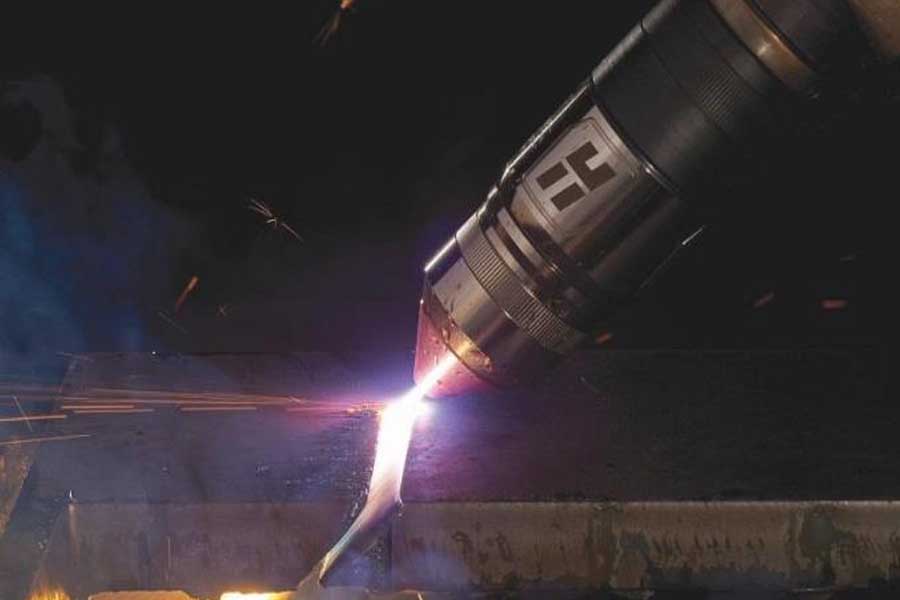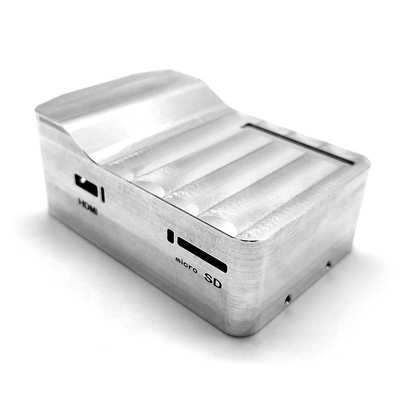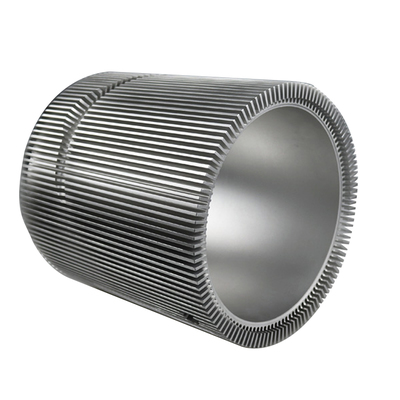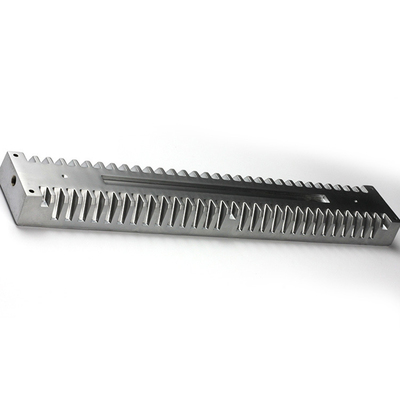What are the four methods of mechanized plasma cutting?
The plasma cutting process is known for its simplicity and ability to cut almost any metal. These qualities, coupled with the productivity it produces, make plasma cutting a generally accepted metal cutting process with a wide range of functions and applications.
Plasma technology
The plasma cutting process has been used commercially since the 1960s, and its flexibility makes it suitable for many applications and functions. In addition to motion control equipment such as CNC cutting machines, punch plasma machines, industrial robots, and pipe cutting machines, plasma processes can be divided into four categories: air plasma, conventional plasma, high-definition and ultra-high-definition.
Air plasma. The air plasma system was originally designed for hand-held torch cutting, using compressed air as the plasma gas, which is relatively simple and low-cost to operate. Their power level output is as low as 12 amps and the maximum cutting thickness is 1⁄8 inch. Up to 125 amps, the cutting capacity is 1-1/2 inches. Most of these systems use inverter power technology, making them easy to carry. Many are equipped with machine torches and have electrical interfaces for mechanized cutting applications, such as on a CNC table.
Conventional mechanized plasma. Generally, plasma systems in this category use a single gas (air or oxygen) and are only suitable for torches that can be installed on the machine. In addition, when used in modern CNC cutting machine applications, they usually have more complex interfaces to provide better performance. The power range of traditional mechanized plasma systems ranges from 130 amps to as high as 1,000 amps.
These systems are designed for high productivity, have medium tolerances, can cut non-ferrous (stainless steel and aluminum) materials up to 6-1⁄4 inches thick, and are the main force for steel service centers, shipyards and heavy equipment manufacturers. Although some manufacturers have invested engineering efforts to improve such systems, they are largely similar to traditional industrial cutting machines that have been in use for decades.
HD plasma. In terms of process development, high-yield sheet and plate cutting is the category that receives the most attention. Therefore, since its introduction in the early 1990s, high-definition plasma cutting systems have made tremendous progress in terms of quality, speed, power levels, operating costs, and recent ease of use.
In high-definition plasma cutting, the plasma arc is forced through a smaller nozzle orifice, making full use of the laws of high-temperature physics. Compared with air cutting and traditional plasma cutting, this makes the cutting edges cleaner and more square, while maintaining an acceptable life of consumables in the torch. Today's high-definition plasma systems are rated between 130 and 800 amperes and can cut from 26 ga. Up to 3 inches on carbon steel and 6-1⁄4 inches on stainless steel and aluminum.
Ultra HD plasma. This type of plasma is sometimes referred to as X-Definition. Compared with conventional high-definition plasma cutting, cutting mild steel can produce consistent results in ISO range 2 and extended ISP range 3 results. Based on ISO 9013, this is an international standard that defines the quality of thermally cut parts from 1 to 5. Range 1 is considered the best. Ultra HD plasma can perform ISO range 2 cutting of thin steel at low current settings.
Those who cut thicker mild steel (3/4 inch thick) will achieve ISO range 3 cut quality for almost the entire consumable life cycle. These cut quality improvements cover all metal types, including aluminum and stainless steel.
In addition, the cutting quality of UHD plasma is more uniform than other types of plasma. During the testing process, engineers found that the parts cut with the new consumables looked almost the same as the parts cut with the consumables with more than 1,000 starts.

technology Update
As we all know, machine movement (precision, acceleration and smoothness), cutting torch height control (piercing height, cutting height, collision avoidance and cycle time) and CAM software (cutting width, lead-in line, lead-in line post-processing) outs and nesting) It plays a major role in affecting any mechanized cutting operation in terms of cutting parts accuracy, operating costs and throughput. The parameters related to these external systems have traditionally been controlled by programmers and machine operators.
A savvy operator needs to pay attention to the multiple setup parameters required to maintain consistent cut quality every day. This may include continuous monitoring of arc voltage, gas flow and pressure, as well as dozens of others to produce the best cut quality (such as power levels, material thickness, and consumables in torch replacement). As a result, cutting operations performed by professional programmers and experienced operators are expected to produce higher quality than operations performed by inattentive or inexperienced employees.
System engineers learned that more stringent and more consistent control of dozens of key operating parameters that affect plasma performance at all levels will further improve the cutting process in the workshop, so they started work. The manufacturers of these systems work closely with suppliers of machine tool CNC, torch height control, and CAD software (often called nesting software). After several years of development work, the latest plasma system uses a full set of CNC cutting machine components to fully automate and coordinate functions that affect cutting quality.
These plasma systems can now accept the same AutoCAD format drawing file input used by the old machine, and combine with the updated CAM software to analyze the features on the part drawing, such as holes, external features, shapes, material types, and thicknesses. Then use this analysis to nest parts; insert the best import/export, cutting speed, amperage, and gas; and set all the cutting parameters that were once controlled by the machine operator.
The result is high-quality plasma-cut parts; round no-tapered holes; consistent cut quality; reduced downtime due to plate collision avoidance technology; fewer or no set-up errors by the operator or programmer, so less waste and Faster cutting cycle time. The advancement of CNC technology uses Windows-based touch screen operator controls, which are very simple to use and greatly reduce the learning curve for new machine operators.
Link to this article: What are the four methods of mechanized plasma cutting?
Reprint Statement: If there are no special instructions, all articles on this site are original. Please indicate the source for reprinting:https://www.cncmachiningptj.com/,thanks!
 3, 4 and 5-axis precision CNC machining services for aluminum machining, beryllium, carbon steel, magnesium, titanium machining, Inconel, platinum, superalloy, acetal, polycarbonate, fiberglass, graphite and wood. Capable of machining parts up to 98 in. turning dia. and +/-0.001 in. straightness tolerance. Processes include milling, turning, drilling, boring, threading, tapping, forming, knurling, counterboring, countersinking, reaming and laser cutting. Secondary services such as assembly, centerless grinding, heat treating, plating and welding. Prototype and low to high volume production offered with maximum 50,000 units. Suitable for fluid power, pneumatics, hydraulics and valve applications. Serves the aerospace, aircraft, military, medical and defense industries.PTJ will strategize with you to provide the most cost-effective services to help you reach your target,Welcome to Contact us ( sales@pintejin.com ) directly for your new project.
3, 4 and 5-axis precision CNC machining services for aluminum machining, beryllium, carbon steel, magnesium, titanium machining, Inconel, platinum, superalloy, acetal, polycarbonate, fiberglass, graphite and wood. Capable of machining parts up to 98 in. turning dia. and +/-0.001 in. straightness tolerance. Processes include milling, turning, drilling, boring, threading, tapping, forming, knurling, counterboring, countersinking, reaming and laser cutting. Secondary services such as assembly, centerless grinding, heat treating, plating and welding. Prototype and low to high volume production offered with maximum 50,000 units. Suitable for fluid power, pneumatics, hydraulics and valve applications. Serves the aerospace, aircraft, military, medical and defense industries.PTJ will strategize with you to provide the most cost-effective services to help you reach your target,Welcome to Contact us ( sales@pintejin.com ) directly for your new project.

- 5 Axis Machining
- Cnc Milling
- Cnc Turning
- Machining Industries
- Machining Process
- Surface Treatment
- Metal Machining
- Plastic Machining
- Powder Metallurgy Mold
- Die Casting
- Parts Gallery
- Auto Metal Parts
- Machinery Parts
- LED Heatsink
- Building Parts
- Mobile Parts
- Medical Parts
- Electronic Parts
- Tailored Machining
- Bicycle Parts
- Aluminum Machining
- Titanium Machining
- Stainless Steel Machining
- Copper Machining
- Brass Machining
- Super Alloy Machining
- Peek Machining
- UHMW Machining
- Unilate Machining
- PA6 Machining
- PPS Machining
- Teflon Machining
- Inconel Machining
- Tool Steel Machining
- More Material





